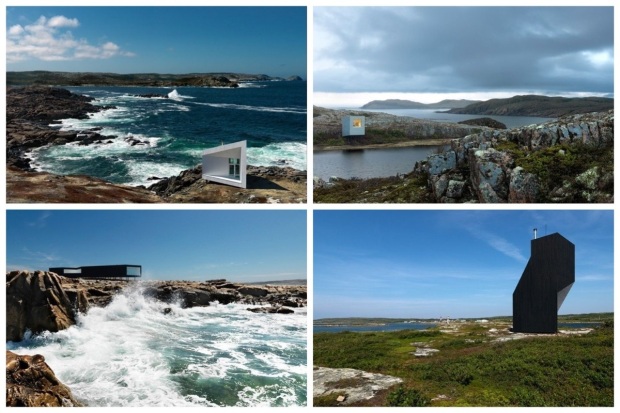Architecture in perfect balance with Nature
Last week a series of photos start appearing in the “architecture media world” that were quite impressive. The first “Squish Studio”: advertised as the ultimate hipster shack, a small artist studio with sharp geometry in the middle of nowhere. This nowhere is Fogo Island in Canada and it is breath taking. I couldn’t stop looking at that small building wondering how it was possible to build in such a natural area and, at the same time, how I envied that hipster guy!
Few days later, another news “Bridge Studio” by the same architecture office, the same location, the same geometric simplicity melting into the overwhelming landscape. I thought to myself, this can’t be a coincidence! This architect is way too lucky and Fogo Islands are insane for allowing such nature invasion by construction!

Squish studio | Bridge studio
Long studio | Tower studio
And here goes my first argument: the problem with media, is that you can’t trust everything you ear or see… Like Winy Maas (the M from MVRDV) said the other day in an interview, the Internet is great, but it certainly is not enough, go to libraries do real research…He is absolutely right, if I hadn’t look for more information I would still be making stupid comments in architecture websites about this work. Instead, I went to look for information about the architecture office – Saunders Architecture (still in the Internet yes, but in this case is perfectly justifiable) and discover that there is a logic for these projects, presented in separate, but actually part of a whole, a bigger picture:
The Shorefast Foundation and the Fogo Island Arts Corporation has commissioned Todd Saunders to design a series of six artists’ studios on various Fogo Island locations. The organization is committed to preserving the Islanders’ traditions and aims at rejuvenating the island through the arts and culture.
The architecture office has only released 4 of the 6 projects commissioned but, I can already say, that I think these guys made a magnificent work. Unlike what many think, I believe it is quite complicated to intervene in places with such natural magnitude, nature has this ability to make you feel small and insignificant and it’s very easy for architects to get lost in their egos and freak out and block or try to stand out, when you have to instead embrace you’re surroundings with humbleness.
The projects clearly share the same conceptual approach – clear geometries, use of natural materials, color contrast – but they explore that concept in various ways, transforming it into a very interesting formal exploration. As you look at the different projects, they are different but simultaneously familiar and this is what makes then so interesting.
They blend with its surroundings independently of the different shapes testifies that is not about form, is always about intent, conceptual approach.
I can’t recall seeing such beautiful marriage between construction and nature, and makes me reflect on how architecture is much more then the array of technology and engineering on sustainability that we see on headline everyday. I must confess the silent rejoice of seeing again architecture at its pure essence, just being itself, nothing more, nothing else.
My second argument is: I’m quite pleased to know that there are places on earth where people realize how small interventions dedicated to art and culture can help revitalize urban life as well as ensure the maintenance of ecological systems.
I have made proposals of this kind in 2 architectural competitions in Portugal that were, in both times, considered inadequate to construct in natural areas and uninteresting (not appealing to the general public). Yet I always believed that one way to ensure the maintenance of fragile ecosystems and their balance with urbanized areas is to use them as places for education and awareness of locals and tourists, and that the best way to do that is to provide non-invasive structures that allow people to experience nature, to learn about it.
Because, most people that live in cities, may not care about nature sustainability because they don’t see it (running in Central Park is not the same as hiking at Fogo Island Shore lune). I believe that, in most case, when people have the chance to be surrounded by natural landscapes they truly learn to appreciate and respect our natural world in a all new way.
It’s strange to me that in a country where people are so close to the sea and river and their surrounding eco-systems there is still this traditional idea, that nature is experienced in urban parks, in the beach in the urban track of the river course while natural areas or eco-systems are to be left “alone” with no construction, no people, no man interventions (even if he is intervening anyway, just not with construction). We can only admire nature from distance or on artificially created natural areas near urban areas. Curiously enough, it seems to be acceptable to have that approach in the middle of nowhere, where you have to drive for hours to reach…it seems that in most cases architecture blends with nature, nature cannot blend with architecture!